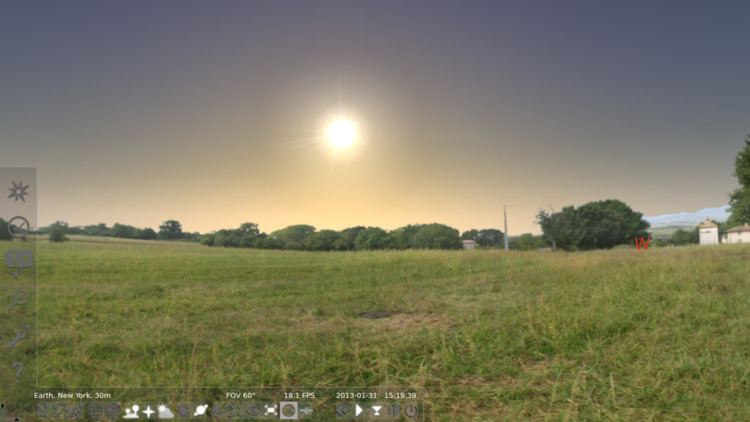Original author(s) Written in C++ (Qt) | Initial release 2001 | |
 | ||
Developer(s) Alexander WolfGeorg ZottiMarcos CardinotGuillaume ChéreauBogdan MarinovTimothy ReavesFlorian Schaukowitsch Stable release 0.15.2 / 21 March 2017; 5 days ago (2017-03-21) Repository code.launchpad.net/stellarium/ | ||
Stellarium is an open-source free-software planetarium, licensed under the terms of the GNU General Public License version 2, available for Linux, Windows and macOS. A port Stellarium called Stellarium Mobile is available for Android, iOS & Symbian as a paid version, being developed by Noctua Software. It uses OpenGL to render a realistic projection of the night sky in real time.
Contents
Stellarium was created by the French programmer Fabien Chéreau, who launched the project in the summer of 2001. Currently, Stellarium is being maintained and developed by Alexander Wolf, Georg Zotti, Marcos Cardinot, Guillaume Chéreau, Bogdan Marinov, Timothy Reaves, Ferdinand Majerech and Jörg Müller. There are a number of other developers who contributed with the development of Stellarium, including Robert Spearman, Johannes Gajdosik, Matthew Gates, Nigel Kerr, and Johan Meuris, who is responsible for the artwork.
Stellarium was featured on SourceForge in May 2006 as Project of the Month.
History
In 2006, Stellarium 0.7.1 won a gold award in the Education category of the Les Trophées du Libre free software competition.
A modified version of Stellarium has been used by the MeerKAT project as a virtual sky display showing where the antennae of the radiotelescope are pointed.
In December 2011, Stellarium was added as one of the "featured applications" in the Ubuntu Software Center.
Features
In terms of sky features, over 600,000 stars from the Hipparcos Catalogue and the Tycho-2 Catalogue are accessible, as well as more than 210 million stars from additional catalogues.
Stellarium also provides asterisms and illustrations of constellations from ten cultures, images of nebulae (full Messier catalogue) and several realistic representations. The Milky Way, atmosphere, sunrise, planets of the solar system and their major moons are all represented in the application. Users can also display stars and other celestial objects as seen from reference points other than the Earth (e.g. Saturn, Phobos, comet C/2006 P1 (McNaught) or any other object defined in the system.ini file)
Stellarium's multi-lingual interface features zoom, time control, in-built scripting to record and playback shows, fisheye projection for planetarium domes, spheric mirror projection for personal domes, telescope control, equatorial and azimuthal grids, twinkling and shooting stars, simulated eclipses, landscapes and other deep sky objects.
Planetarium dome projection
The fisheye and spherical mirror distortion features allow Stellarium to be projected onto domes. Spherical mirror distortion is used in projection systems that utilize a digital video projector and a first surface convex spherical mirror to project images onto a dome. Such systems are generally cheaper than traditional planetarium projectors and fish-eye lens projectors and for that reason are used in budget and home planetarium setups where projection quality is less important.
Several companies that build and sell digital planetarium systems use Stellarium, such as e-Planetarium. Digitalis Education Solutions, which helped develop Stellarium, created and now uses a fork called Nightshade which is specifically tailored to planetarium use.
VirGO
VirGO is a Stellarium plugin, a visual browser for the European Southern Observatory (ESO) Science Archive Facility that allows astronomers to browse professional astronomical data. It is no longer supported or maintained; the last version is 1.4.5, dated 15 January 2010.
Stellarium Mobile
Stellarium Mobile is a fork of Stellarium, developed by some of the Stellarium team members. It is targeting mobile devices running Symbian, Maemo, Android and iOS. Some of the mobile optimisations have been integrated to the mainline Stellarium.
